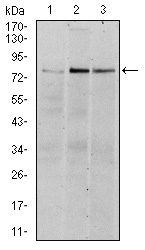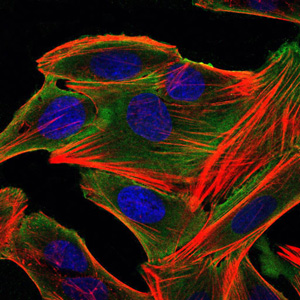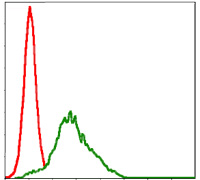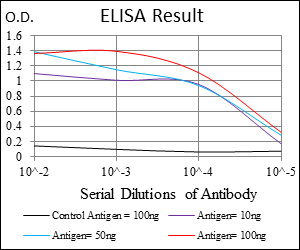Rsk-2 Monoclonal Antibody
- Catalog No.:YM0565
- Applications:WB;IF;FCM;ELISA
- Reactivity:Human
- Target:
- RSK2
- Fields:
- >>MAPK signaling pathway;>>Oocyte meiosis;>>mTOR signaling pathway;>>Thermogenesis;>>Long-term potentiation;>>Neurotrophin signaling pathway;>>Progesterone-mediated oocyte maturation;>>Insulin resistance;>>Yersinia infection;>>Chemical carcinogenesis - receptor activation
- Gene Name:
- RPS6KA3
- Protein Name:
- Ribosomal protein S6 kinase alpha-3
- Human Gene Id:
- 6197
- Human Swiss Prot No:
- P51812
- Mouse Swiss Prot No:
- P18654
- Immunogen:
- Purified recombinant fragment of human Rsk-2 expressed in E. Coli.
- Specificity:
- Rsk-2 Monoclonal Antibody detects endogenous levels of Rsk-2 protein.
- Formulation:
- Liquid in PBS containing 50% glycerol, 0.5% BSA and 0.02% sodium azide.
- Source:
- Monoclonal, Mouse
- Dilution:
- WB 1:500 - 1:2000. IF 1:200 - 1:1000. Flow cytometry: 1:200 - 1:400. ELISA: 1:10000. Not yet tested in other applications.
- Purification:
- Affinity purification
- Storage Stability:
- -15°C to -25°C/1 year(Do not lower than -25°C)
- Other Name:
- RPS6KA3;ISPK1;MAPKAPK1B;RSK2;Ribosomal protein S6 kinase alpha-3;S6K-alpha-3;90 kDa ribosomal protein S6 kinase 3;p90-RSK 3;p90RSK3;Insulin-stimulated protein kinase 1;ISPK-1;MAP kinase-activated protein kinase 1b;MAPK-activated
- Molecular Weight(Da):
- 84kD
- References:
- 1. Mol Cell. 2009 Jan 16;33(1):109-16.
2. Cancer Res. 2009 May 15;69(10):4398-406.
- Background:
- ribosomal protein S6 kinase A3(RPS6KA3) Homo sapiens This gene encodes a member of the RSK (ribosomal S6 kinase) family of serine/threonine kinases. This kinase contains 2 non-identical kinase catalytic domains and phosphorylates various substrates, including members of the mitogen-activated kinase (MAPK) signalling pathway. The activity of this protein has been implicated in controlling cell growth and differentiation. Mutations in this gene have been associated with Coffin-Lowry syndrome (CLS). [provided by RefSeq, Jul 2008],
- Function:
- catalytic activity:ATP + a protein = ADP + a phosphoprotein.,cofactor:Magnesium.,disease:Defects in RPS6KA3 are the cause of Coffin-Lowry syndrome (CLS) [MIM:303600]; an X-linked dominant disorder characterized by severe mental retardation with facial and digital dysmorphisms, and progressive skeletal deformations.,enzyme regulation:Activated by multiple phosphorylations on threonine and serine residues.,function:Serine/threonine kinase that may play a role in mediating the growth-factor and stress induced activation of the transcription factor CREB.,PTM:Autophosphorylated on Ser-386, as part of the activation process.,PTM:Ser-227 phosphorylation promotes Ser-386 phosphorylation and leads to basal activation. Full activation by growth factors requires additional phosphorylation on Ser-369.,similarity:Belongs to the protein kinase superfamily. AGC Ser/Thr protein kinase family. S6 kinase
- Subcellular Location:
- Nucleus . Cytoplasm .
- Expression:
- Expressed in many tissues, highest levels in skeletal muscle.
- June 19-2018
- WESTERN IMMUNOBLOTTING PROTOCOL
- June 19-2018
- IMMUNOHISTOCHEMISTRY-PARAFFIN PROTOCOL
- June 19-2018
- IMMUNOFLUORESCENCE PROTOCOL
- September 08-2020
- FLOW-CYTOMEYRT-PROTOCOL
- May 20-2022
- Cell-Based ELISA│解您多样本WB检测之困扰
- July 13-2018
- CELL-BASED-ELISA-PROTOCOL-FOR-ACETYL-PROTEIN
- July 13-2018
- CELL-BASED-ELISA-PROTOCOL-FOR-PHOSPHO-PROTEIN
- July 13-2018
- Antibody-FAQs
- Products Images

- Western Blot analysis using Rsk-2 Monoclonal Antibody against HeLa (1), MCF-7 (2), and HepG2 (3) cell lysate.

- Immunofluorescence analysis of HepG2 cells using Rsk-2 Monoclonal Antibody (green). Blue: DRAQ5 fluorescent DNA dye. Red: Actin filaments have been labeled with Alexa Fluor-555 phalloidin.

- Flow cytometric analysis of HepG2 cells using Rsk-2 Monoclonal Antibody (green) and negative control (red).




